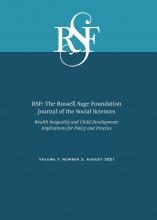Research Article
Open Access
Parental Debt and Child Well-Being: What Type of Debt Matters for Child Outcomes?
Lenna Nepomnyaschy, Allison Dwyer Emory, Kasey J. Eickmeyer, Maureen R. Waller, Daniel P. Miller
RSF: The Russell Sage Foundation Journal of the Social Sciences August 2021, 7 (3) 122-151; DOI: https://doi.org/10.7758/RSF.2021.7.3.06
Lenna Nepomnyaschy
aAssociate professor at the Rutgers School of Social Work, United States
Allison Dwyer Emory
bAssistant professor in the Department of Sociology at the University at Buffalo, United States
Kasey J. Eickmeyer
cSenior research methodologist at the Center for Policing Equity, United States
Maureen R. Waller
dProfessor in the Department of Policy Analysis and Management at Cornell University, United States
Daniel P. Miller
eAssociate professor at the Boston University School of Social Work, United States

REFERENCES
- ↵
- Achenbach, Thomas M., and
- Leslie Rescorla
- ↵
- ↵
- Arthur, Joey
- ↵
- ASCEND
- ↵
- ↵
- ↵
- ↵
- Berger, Lawrence M., and
- Jason N. Houle
- ↵
- ↵
- Berger, Lawrence M.,
- Christina Paxson, and
- Jane Waldfogel
- ↵
- ↵
- ↵
- Bricker, Jesse,
- Lisa J. Dettling,
- Alice Henriques,
- Joanne W. Hsu,
- Lindsay Jacobs,
- Kevin B. Moore,
- Sarah Pack,
- John Sabelhaus,
- Jeffrey Thompson, and
- Richard A. Windle
- ↵
- ↵
- ↵
- Cancian, Maria, and
- Daniel R. Meyer
- ↵
- Carlson, Marcia J., and
- Katherine A. Magnuson
- ↵
- ↵
- ↵
- ↵
- ↵
- Collins, Linda M
- ↵
- ↵
- Conger, Rand D.,
- Katherine J. Conger, and
- Monica J. Martin
- ↵
- Conger, Rand D.,
- Xiaojia Ge,
- Glen H. Elder,
- Frederick O. Lorenz, and
- Ronald L. Simons
- ↵
- ↵
- Derogatis, Leonard R., and
- Kathryn L. Savitz
- ↵
- Desmond, Matthew
- ↵
- Drentea, Patricia, and
- Paul J. Lavrakas
- ↵
- Drentea, Patricia, and
- John R. Reynolds
- ↵
- ↵
- ↵
- ↵
- Dwyer Emory, Allison,
- Lenna Nepomnyaschy,
- Maureen R. Waller,
- Daniel P. Miller, and
- Alexandra Haralampoudis
- ↵
- Edin, Kathryn, and
- Timothy Jon Nelson
- ↵
- Edin, Kathryn, and
- H. Luke Shaefer
- ↵
- Elliott, William,
- Mesmin Destin, and
- Terri Friedline
- ↵
- Federal Reserve Bank of New York
- ↵
- ↵
- ↵
- Fourcade, Marion, and
- Kieran Healy
- ↵
- Garfinkel, Irwin,
- Sara S. McLanahan, and
- Thomas L. Hanson
- ↵
- ↵
- ↵
- ↵
- ↵
- ↵
- Hankin, Benjamin L.,
- Robin Mermelstein, and
- Linda Roesch
- ↵
- Harris, Alexes
- ↵
- ↵
- ↵
- Houle, Jason N
- ↵
- Houle, Jason N., and
- Danya E. Keene
- ↵
- Johnson, David R., and
- Rebekah Young
- ↵
- ↵
- ↵
- Kennedy, Sheela, and
- Larry Bumpass
- ↵
- Kessler, Ronald C.,
- Gavin Andrews,
- Daniel Mroczek,
- Bedirhan Ustun, and
- Hans-Ulrich Wittchen
- ↵
- ↵
- ↵
- ↵
- Magnuson, Katherine, and
- Elizabeth Votruba-Drzal
- ↵
- Marsh, Herbert W.
- ↵
- Maumary-Gremaud, Anne
- ↵
- ↵
- ↵
- ↵
- ↵
- Miller, Portia,
- Tamara Podvysotska,
- Laura Betancur, and
- Elizabeth Votruba-Drzal
- ↵
- Mishel, Lawrence,
- Elise Gould, and
- Josh Bivens
- ↵
- Mistry, Rashmita S.,
- Elizabeth A. Vandewater,
- Aletha C. Huston, and
- Vonnie C. McLoyd
- ↵
- Moulton, Vanessa,
- Alissa Goodman,
- Bilal Nasim,
- George B. Ploubidis, and
- Ludovica Gambaro
- ↵
- National Council of State Legislatures
- ↵
- Nepomnyaschy, Lenna,
- Katherine A. Magnuson, and
- Lawrence M. Berger
- ↵
- ↵
- ↵
- New York State
- ↵
- Office of Child Support Enforcement
- ↵
- Office of the Inspector General
- ↵
- Orr, Amy J
- ↵
- ↵
- Pate, David J
- ↵
- ↵
- ↵
- Putze, Dennis
- ↵
- ↵
- Reading, Richard, and
- Shirley Reynolds
- ↵
- Reichman, Nancy,
- Julien Teitler,
- Irwin Garfinkel, and
- Sara McLanahan
- ↵
- Roberts, Paula, and
- Michelle Vinson
- ↵
- ↵
- ↵
- Rutter, Michael,
- Avshalom Caspi, and
- Terrie E. Moffitt
- ↵
- ↵
- ↵
- ↵
- Smeeding, Timothy,
- Irwin Garfinkel, and
- Ronald B. Mincy
- ↵
- ↵
- Sorensen, Elaine
- ↵
- Sorensen, Elaine
- ↵
- Sorensen, Elaine,
- Arthur Pashi, and
- Melody Morales
- ↵
- Sorensen, Elaine,
- Liliana Sousa, and
- Simon Schaner
- ↵
- Stack, Carol B
- ↵
- Sweet, Elizabeth,
- Arijit Nandi,
- Emma K. Adam, and
- Thomas W. McDade
- ↵
- Teitler, Julien O.,
- Nancy E. Reichman, and
- Susan Sprachman
- ↵
- Turetsky, Vicki
- ↵
- Turetsky, Vicki, and
- Maureen R. Waller
- ↵
- ↵
- Um, Hyunjoon
- ↵
- U.S. Census Bureau
- ↵
- ↵
- Western, Bruce, and
- Christopher Wildeman
- ↵
- Wheaton, Laura, and
- Elaine Sorensen
- ↵
- Wilson, William Julius
- ↵
- Yeung, W. Jean, and
- Dalton Conley
In this issue
Parental Debt and Child Well-Being: What Type of Debt Matters for Child Outcomes?
Lenna Nepomnyaschy, Allison Dwyer Emory, Kasey J. Eickmeyer, Maureen R. Waller, Daniel P. Miller
RSF: The Russell Sage Foundation Journal of the Social Sciences Aug 2021, 7 (3) 122-151; DOI: 10.7758/RSF.2021.7.3.06
Jump to section
Related Articles
- No related articles found.
Cited By...
- No citing articles found.





